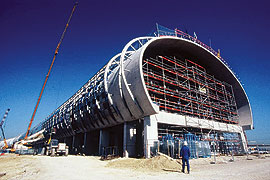 |
|
UNDER WAY Focus of probe has shifted from columns under concourse at Charles de Gaulle Airport to struts that connect fingers to concrete shell. (Photo courtesy of Eiffel /Laubeuf) |
External tubular steel struts puncturing the shell-like concrete roof of Paris Charles de Gaulle Airports newest concourse likely triggered the May 23 collapse, say preliminary findings of a French government probe released last week. But investigators have yet to explain why the structures behavior changed suddenly on a Sunday morning, 30 months after its construction. The collapse killed four people.
The lower number of struts in play reduced the bending strength of part of the 650-meter-long shell, causing it to break in flexure, suspect investigators. However, a conclusive explanation is unlikely before the end of this year, says Jean-Armand Calgaro, one of four experts on the government commission. The commission, appointed two days after the collapse and led by senior civil engineer Jean Berthier, was not asked to apportion blame.
Berthiers team has ruled out a shearing failure of columns supporting the flat tube-shaped roof as the cause of the disaster. Subject to further surveys, the commission also eliminated foundation pile settlement and the legacy of known column construction problems as likely causes.
Forming part of the airports terminal 2E, the concourse is located parallel to the main passenger building and is linked to it by an isthmus connector (ENR 5/31 p. 10). On both sides of the central isthmus building, a set of three elevated passages enter the concourse.
|
The roof rises from the second floor of the concourse. From its roots, over 26 m apart, the roof bulges out forming a flat arch. However, the roof is not fixed rigidly to its supports, allowing for thermal and other movement. This makes it function more like a bending beam than the arch it resembles, say sources.
According to Berthiers team, the roof structure is made up of 10 shells separated by glazed strips. Each section is known to have been assembled in 4-m lengths, each composed of three 30-centimeter-thick precast elements. The elements were stitched together with cast-in-place concrete. At their bases, the arches tie into beams seated on sliding bearings running along two rows of columns.
To increase the roof sections bending resistance, steel beams rise like curved fingers from both bases and are anchored to the shell where it flattens out. Acting...
